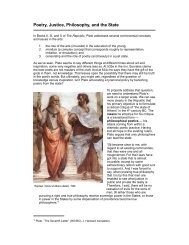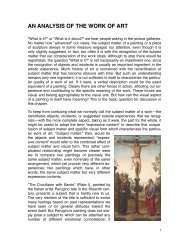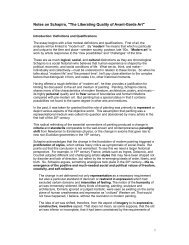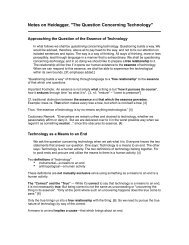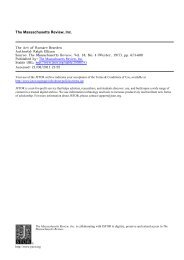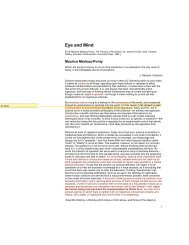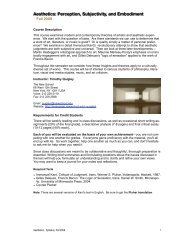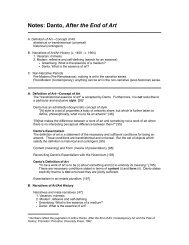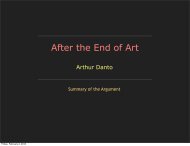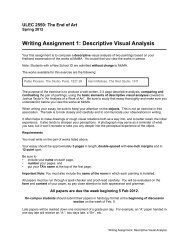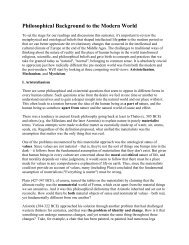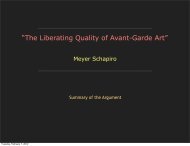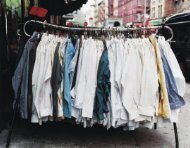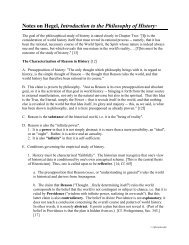Experience vs. Theory: Romare Bearden and Abstract ...
Experience vs. Theory: Romare Bearden and Abstract ...
Experience vs. Theory: Romare Bearden and Abstract ...
Create successful ePaper yourself
Turn your PDF publications into a flip-book with our unique Google optimized e-Paper software.
<strong>Experience</strong> <strong>vs</strong>. <strong>Theory</strong>: <strong>Romare</strong> <strong>Bearden</strong> <strong>and</strong> <strong>Abstract</strong> ExpressionismMatthew S. Witko<strong>vs</strong>kyBlack American Literature Forum, Vol. 23, No. 2, Fiction Issue. (Summer, 1989), pp. 257-282.Stable URL:http://links.jstor.org/sici?sici=0148-6179%28198922%2923%3A2%3C257%3AEVTRBA%3E2.0.CO%3B2-TBlack American Literature Forum is currently published by St. Louis University.Your use of the JSTOR archive indicates your acceptance of JSTOR's Terms <strong>and</strong> Conditions of Use, available athttp://www.jstor.org/about/terms.html. JSTOR's Terms <strong>and</strong> Conditions of Use provides, in part, that unless you have obtainedprior permission, you may not download an entire issue of a journal or multiple copies of articles, <strong>and</strong> you may use content inthe JSTOR archive only for your personal, non-commercial use.Please contact the publisher regarding any further use of this work. Publisher contact information may be obtained athttp://www.jstor.org/journals/slu.html.Each copy of any part of a JSTOR transmission must contain the same copyright notice that appears on the screen or printedpage of such transmission.The JSTOR Archive is a trusted digital repository providing for long-term preservation <strong>and</strong> access to leading academicjournals <strong>and</strong> scholarly literature from around the world. The Archive is supported by libraries, scholarly societies, publishers,<strong>and</strong> foundations. It is an initiative of JSTOR, a not-for-profit organization with a mission to help the scholarly community takeadvantage of advances in technology. For more information regarding JSTOR, please contact support@jstor.org.http://www.jstor.orgTue Aug 14 11:30:12 2007
<strong>Experience</strong> <strong>vs</strong>. <strong>Theory</strong>: <strong>Romare</strong> <strong>Bearden</strong> <strong>and</strong><strong>Abstract</strong> ExpressionismMatthew S. Witko<strong>vs</strong>kyFrom his discharge at the end of World War I1 until hisparticipation in the Civil-Rights-oriented art group known as Spiralin 1962-63, <strong>Romare</strong> <strong>Bearden</strong> was very much involved with theforemost American art movement of that time, <strong>Abstract</strong>Expressionism. For three years after the war, <strong>Bearden</strong> exhibitedwith soon-to-be celebrated <strong>Abstract</strong> Expressionists such as RobertMotherwell, William Baziotes, Adolph Gottlieb, David Hare, <strong>and</strong>others at Sam Kootz's gallery, <strong>and</strong> his work evolved, both then <strong>and</strong>afterward, along lines which reflect these <strong>and</strong> other contemporaryartists' formal concerns throughout the late '40s <strong>and</strong> the '50s. Still,after 1950, <strong>Bearden</strong>'s work was exhibited almost exclusively withthat of other black artists, rather than that of the movement'sestablished proponents. After converging ever more visibly with<strong>Abstract</strong> Expressionism's repertoire of aesthetic <strong>and</strong> philosophicalconcerns during the 1950s' <strong>Bearden</strong> seemed suddenly to reject hiswork of the previous decade, both in medium <strong>and</strong> content, <strong>and</strong> toconcentrate on the work in collage that has since brought himlasting recognition.In fact, however, <strong>Bearden</strong>'s collages <strong>and</strong> photostats of themid-1 960s onwards bear fundamental resemblances to his abstract<strong>and</strong> semi-abstract works of the previous years; more importantly,they reveal an attitude towards <strong>Abstract</strong> Expressionism which hasgreat relevance to the movement's methods <strong>and</strong> aims. In choosingto base his images on scenes rooted in his own experience, <strong>Bearden</strong>does not repudiate the need-greatly stressed by the <strong>Abstract</strong>Expressionists-to convey messages of universal, timeless, <strong>and</strong>- -A native of Brooklyn, New York, Matthew S. Witko<strong>vs</strong>ky is a graduate studentin art history at Yale University.Black American Literature Forum,Volume 23, Number 2 (Summer 1989)@ 1989 Indiana State University
258 Matthew S. Witko<strong>vs</strong>kyhence mythic importance; rather, he claims that universal emotions<strong>and</strong> actions may be most effectively captured via local, historicallyspecific scenes.<strong>Bearden</strong>'s evolution parallels that of the core of <strong>Abstract</strong>Expressionist painters. Beginning around 1938, he studied at theArt Students' League under German political artist George Grosz.Although he never joined the Federal Arts Project, as did severalsubsequent <strong>Abstract</strong> Expressionists, he painted within the formalparameters of American Regionalism <strong>and</strong> Social Realism prevalentduring the Depression. In addition, he spent a great deal of timewith Harlem artists such as Jacob Lawrence, Augusta Savage, <strong>and</strong>Ernest Critchlow, who were heavily involved with the Project, itsaims, <strong>and</strong> methods. Although he agreed with many Project artiststhat art should be "an instrument of social change" ("RectangularStructure" 1l), <strong>Bearden</strong> early on expressed an interest in formalconcerns in art which transcended the specifics of his time <strong>and</strong>place <strong>and</strong> of his position as a black artist.In a 1934 article, <strong>Bearden</strong> made known his opposition to the effortsof institutional patrons of black art,such as the Harmon Foundation,to limit blacks to depicting their "ethnic richness" in order toconvince white viewers of their cultural integrity. Black artists ofthe day, he felt, were "at best hackneyed <strong>and</strong> uninspired." "Theyhave looked at nothing with their own eyes. . . . they have evolvednothing original or native like the spiritual, or jazz music" ("TheNegro Artist" 371). <strong>Bearden</strong> praised contemporary art movementsfor substituting "for mere photographic realism a search for innertruths" <strong>and</strong> called upon blacks to portray these truths in their ownart. He did not, however, dem<strong>and</strong> that any artist sacrificerepresentational art in order to probe themes of universalimportance; after all, he wrote, "Rembr<strong>and</strong>t painted the ordinaryDutch people about him, but he presented their emotions in sucha way that their appeal was universal" (372).Despite his debatable assessment of Rembr<strong>and</strong>t, <strong>Bearden</strong> raisedsome very important points with this essay. Wanting to exp<strong>and</strong> hisfreedom as a black artist, he established a potential link betweenhis art, or that of any black person, <strong>and</strong> one of the most renownedartists of the Western tradition. He saw no reason that an artist ofcolor should not have as much claim to universality as a white artist.<strong>Bearden</strong>'s emphasis on "real-life" source material-the "ordinarypeople" he saw in Rembr<strong>and</strong>t's paintings-nevertheless qualifiedthis highly modernist drive toward universal significance in a waywhich greatly affected his relation to the <strong>Abstract</strong> Expressionistmovement.
<strong>Romare</strong> <strong>Bearden</strong> <strong>and</strong> <strong>Abstract</strong> Expressionism 259During his studies at the Art Students' League, <strong>Bearden</strong> readavidly <strong>and</strong>, from 1936 onwards, received a great deal of exposureto European art-in addition to the training Grosz provided-fromthe writer Claude McKay <strong>and</strong> fellow painter Carl Holty (Hatchinterview). Before he was drafted in 1942, he had begun to take aserious look at twentieth-century artists like Picasso <strong>and</strong> Cezanne,even though he did not employ what he called their "spaceidealsn1-their revolutionary rearrangement of forms in relation tothe picture plane-in his own painting. In his studio on 125th Street,surrounded by members of the Harlem Arts Guild <strong>and</strong> other uptowncultural movements, <strong>Bearden</strong> thus pursued interests rather similarto those in which the <strong>Abstract</strong> Expressionists engaged downtown.Upon his return from military reserve duty in 1945, <strong>Bearden</strong> wasasked to show at the Samuel Kootz Gallery in New York, <strong>and</strong> it washere he enjoyed his first broad recognition. He had had exhibitssince 1941, including two while he was stationed in the army,2 butthe group <strong>and</strong> one-man shows Kootz gave him represented a hugeimprovement in his status. In addition to his higher visibility,<strong>Bearden</strong> now shared wall space with several artists who, during thelater '40s, were beginning to attract some attention in the art pressprincipally,Robert Motherwell, William Baziotes, Adolph Gottlieb,<strong>and</strong> David Hare. Later, Hans Hofmann's <strong>and</strong> Arshile Gorky's workswere exhibited at Kootz (Gorky's posthumously), <strong>and</strong> Pablo Picassobecame a celebrated addition to the gallery with a show in 1941,followed by a permanent contract after Kootz reorganized in the'50s.<strong>Bearden</strong>'s inclusion in this gallery, which might seem fortuitousor unexpected in retrospect, made perfect sense at the time,because his formal concerns <strong>and</strong> subject matter coincided with hisfellow artists' in a way that could only add to the gallery's thematicunity. <strong>Bearden</strong> started his tenure at Kootz with a series ofwatercolors <strong>and</strong> oils, collectively entitled "The Passion of Christ,"based on the Biblical books of Mark <strong>and</strong> Matthew. Kootz placedit second in his 1945-46 season, installing it in October, <strong>and</strong> itreceived praise from a number of New York critics. Edward AldenJewell, a somewhat forward-looking reviewer for the New YorkTimes, praised <strong>Bearden</strong>'s "develop[ment] from social interpretationof the depression days, Negro subjects, illustrations <strong>and</strong> genrepainting to its present level of semi-abstraction" (Holt 6). <strong>Bearden</strong>,according to this analysis, had advanced from a supposedly"debilitating" focus on Regionalist <strong>and</strong> "ethnic" concerns to astylistic approach which participated in the post-war aims of avantgardeAmerican art.
260 Matthew S. Witko<strong>vs</strong>kyIn an artist's statement prefacing the show's catalog, <strong>Bearden</strong>expressed a few of the concerns characteristic of the embryonic<strong>Abstract</strong> Expressionist circle, most specifically the need to depictmyths in an attempt to convey universal human values <strong>and</strong> reactions."This myth," he wrote, referring to Christ's life, death, <strong>and</strong>resurrection, "is . . . perhaps the greatest expression of man'shumanism." Because of Christ's influence on man's "humanistic"spirit, <strong>Bearden</strong> maintained, Christ's actual existence is unimportant:"What is important, is that the idea [of him] has lived in men."Christ's stature as a mythic concept thus transcends his physicalexistence in time <strong>and</strong> space, so that his actual life <strong>and</strong> deeds servereally as mere starting points for any artistic interpretation of hisimportance. Accordingly, <strong>Bearden</strong> emphasized the spiritual intentof his work rather than its specific Biblical inspiration: "Myconcern," he concluded, "is with those universals that must bedigested by the mind <strong>and</strong> cannot be merely seen by the eye." Asimilar preference for the symbolic, abstracted persistence ofcertain acts or heroes, as opposed to an attention to their historicalcontexts, has been observed in the work of a number of New YorkSchool artists: in Motherwell's commemoration of the Spanish CivilWar (Collins), for instance; in Pollock's investigation of NorthwestCoast Indian art (Rushing); in Rothko's <strong>and</strong> Newman'sinterpretations of Biblical stories; <strong>and</strong> in the interest in Greek mythdemonstrated by many of these artists. This ahistorical focus onmythical ideas underlies, for instance, Newman's introduction toa 1941 group show at Betty Parsons' gallery, "The IdeographicPicture," in which he claimed that to the Kwakiutl artist a "shapewas a . . . vehicle for an abstract thought-complex" rather than anillustration of a specific event.One of the works in <strong>Bearden</strong>'s first show at Kootz is a portrayalof the Last Supper, showing Christ surrounded at the table by threeof his disciples (Fig. 1). Despite his emphasis on the mythical ideaof Christ, followed by the assertion that "delineation of the subjectmatter should not constitute an end in itself" (statement for "ThePassion of Christ"), <strong>Bearden</strong>'s figures here are relatively realisticfor those in a mid-1940s' avant-garde art work. Such direct usageof literary <strong>and</strong> artistic models would disappear in <strong>Bearden</strong>'s few1950s' shows, but this Cenacolo scene is easily identifiable, as arefigures in <strong>Bearden</strong>'s other "Passion of Christ" drawings <strong>and</strong>paintings. Body parts have been stylized into abstract geometricforms, but lines of black ink define distinct <strong>and</strong> coherent volumetricentities in a manner partly reminiscent of early Cubism, <strong>and</strong> partlyof fourteenth-century religious panels.
<strong>Romare</strong> <strong>Bearden</strong> <strong>and</strong> <strong>Abstract</strong> Expressionism 26 1Fig. 1. The Last Supper, from "The Passion of Christ," 1945. Ink <strong>and</strong>watercolor, 24 x 18". Private collection, New York.<strong>Bearden</strong> was fascinated, as he later recalled, both by Duccio <strong>and</strong>by Picasso, but his use of these two artists' styles alters theircharacter in highly innovative ways. His line, for instance, heavilydefines each form's contours <strong>and</strong> accentuates the overlapping offigures which Duccio used to indicate depth, but <strong>Bearden</strong> breaks
262 Matthew S. Witko<strong>vs</strong>kyup the solid definition of mass far more than did the Renaissanceartist. Nor does this discontinuous formal structure simply furtherPicasso's planar fragmentation, because <strong>Bearden</strong>'s lines indicatethe motion of human interaction as well; they add to the scene'scontent, rather than simply disrupting its form. <strong>Bearden</strong>'s colorexpresses a rhythm <strong>and</strong> Expressionist energy independent of itsdes5riptive function, so that it is only partly the servant of naturalisticrepresentation <strong>and</strong> partly a pictorial element unto itself.Thus, as Christ turns, his face <strong>and</strong> that of the disciple to his leftjump forward a little toward each other, while their bodies fuse inan overlay of reds <strong>and</strong> yellows. The small green quadrangle thatseparates their bodies defines, in a similar way, the pocket ofenergy created by their interaction. To give two other examples,the greenish circle of color that represents a piece of fruit on thetable rolls out of the ink-drawn shell that once held it, <strong>and</strong> the redrectangle used to fill in a h<strong>and</strong> (bottom left) stretches out beyondits own fingers to grasp the chalice. Color <strong>and</strong> line describe boththree-dimensional forms <strong>and</strong> flat canvas, but they serve ultimatelyto evoke a dynamic interchange of human energies, a sort of"communion" that, because of its basis in abstract form, cantranscend the specifics of time <strong>and</strong> place in its value for all humanity.If <strong>Bearden</strong>'s heavy, fragmentary lines recall Picasso's Cubism, thefree-floating color in this <strong>and</strong> other works suggests an interest inSurrealism, particularly in the explorations of one-time SurrealistJoan Miro. Mir6 <strong>and</strong> Picasso were probably the two older artists whomost preoccupied the imaginations of new artists in the 1940s, soit is not surprising that <strong>Bearden</strong> should have studied theirapproaches. <strong>Bearden</strong> befriended Miro in New York; one bit ofpraise he subsequently wrote about the artist, in fact, ties the twoseminal figures together <strong>and</strong> substantiates the approach observedin <strong>Bearden</strong>'s drawing of The Last Supper. "It was Mir6," he notesin his journal, "who freed painting from the tight Cubist form. Hesaid, 'I forsook the structure <strong>and</strong> listened to the voice of poetry' "(26).As a 1986 show of twenty <strong>Abstract</strong> Expressionist artists at theNewport Harbor Art Museum demonstrates, this interest in Cubiststructure, combined with a desire to overcome its rigidity byfollowing more "poetic" inner drives, guided many artists duringthe 1940s. Motherwell's 1944 drawing Three Important Personages(Fig. 2), which was included in this show, contains severalsimilarities to <strong>Bearden</strong>'s watercolors. Polygonal cutouts of colorrelate to one another in a highly abstract, rhythmic way, definingenergy as much as spatial relationships among the figures. <strong>Bearden</strong>
<strong>Romare</strong> <strong>Bearden</strong> <strong>and</strong> <strong>Abstract</strong> Expressionism 263Fig. 2. Robert Mothemell, Tlvee Important Personages, 1944. Ink on paper,11 x 14". Coll. Richard E. Lang <strong>and</strong> Jane M. Davis, Median, Washington.Photo by Paul Macapia.implies less depth, <strong>and</strong> hence fewer perspectival contradictions,than Motherwell, who sets his middle "personage" on a recedingplane of color. His overlapping of bodies in The Last Supper,though, echoes the effect achieved by Motherwell's use ofconnecting lines to unite the three figures' personal energies.Motherwell <strong>and</strong> <strong>Bearden</strong> were more reserved in their explorationof water-based media at this point than in subsequent years, butthey have both begun to emphasize fluidity in these works-Motherwell's background planes, for instance, have the sameuneven wash <strong>and</strong> wavering, irregular contours as <strong>Bearden</strong>'s"liberated fruit. <strong>Bearden</strong> calls three-dimensionality into questionby re-using, in the style of C6zanne, Fauves, <strong>and</strong> Cubists alike, thedevice of the upturned table top; Motherwell questions theimportance of shading via a schematized crosshatching akin toPicasso's parodic "Neo-Impressionist'' dots. In other works, though,such as Three Figures Shot (Fig. 3), Motherwell uses the fluid spotseven more for their pure energy <strong>and</strong> anger, whereas <strong>Bearden</strong>'stendency toward lyricism keeps him from such violent effects, a
264 Matthew S. Witko<strong>vs</strong>kyFig. 3. Robert Mothemell, T he Figures Shot, 1944. Colored ink on paper,11 3/8 x 14%". Coll. of Whitney Museum of American Art, New York.preference which separates him from later developments in<strong>Abstract</strong> Expressionist art.On the whole, therefore, <strong>Romare</strong> <strong>Bearden</strong>'s artistic concernsduring this period compare quite closely to those of Kootz's otherartists, <strong>and</strong> to New York artists outside the gallery as well. His formalinterests, such as the interrelation of line <strong>and</strong> color on a planarsurface, <strong>and</strong> his vibrant <strong>and</strong> energetic compositions correspond to<strong>Abstract</strong> Expressionist tendencies as much as his stated preferencefor myths <strong>and</strong> legendary figures of universal, humanisticimportance. If his choice of subject matter during this period stemsat all from his own personal background, it is only by virtue of hisservice in the war. According to one of <strong>Bearden</strong>'s friends, HarryB. Henderson, <strong>Bearden</strong> "never talked about" the war, but hisselection of Christ was seen at the time by Banie Stavis in his prefaceto a 1947 show as a young sergeant's recognition of "an unparalleledsymbol of man's humanity" during a period when such humanityseemed utterly nonexistent. <strong>Bearden</strong>'s next series, inspired by thepoetry of Federico Garcia Lorca, involves portrayals of bullfightersengaged in ritualistic combat (Fig. 4). Sociological rituals fascinated
<strong>Romare</strong> <strong>Bearden</strong> <strong>and</strong> <strong>Abstract</strong> Expressionism 265Fig. 4. What a Great BdEghter in the Ring, from "Llanto pox un torero"(Federico Garcia Lorca series), c. 1941. Ink <strong>and</strong> watercolor, 18 x 24". Privatecoll., New York.<strong>Bearden</strong> all his life, but in this case he may also be paying tributeto Lorca, a victim of Spain's Civil War, as Motherwell does in hisElegy to the Spanish Republic (At Five in the Afternoon).The ensemble of <strong>Bearden</strong>'s series from 1945 to 1948 suggests aswell, however, an ongoing interest in literature <strong>and</strong> its relation topainting, which does set <strong>Bearden</strong> apart from his fellow galleryartists. <strong>Bearden</strong> used episodes from Rabelais' first book ofGargantua <strong>and</strong> Pantagzuel <strong>and</strong> Homer's Iliad as starting points forhis own compositional explorations during these years, consideringthem elemental pieces of subject matter which he then sought toarrange with as much rhythm <strong>and</strong> force-as complex a system ofpunctuation, in a way-as he felt the great writers used. Catalognotes for "The Iliad," held in 1948 at the Niveau Gallery, reveal adesire to maintain the autonomy of this art in relation to <strong>Bearden</strong>'ssubject matter: "The brilliant watercolors by <strong>Romare</strong> <strong>Bearden</strong> arenot illustrations, as they do not refer to any particular episodes orpersonages in the Iliad." Nonetheless, <strong>Bearden</strong>'s interest inliterature is undeniable, <strong>and</strong> his removal of literary subject matter
Matthew S. Witko<strong>vs</strong>kyin the '50s became a source of great difficulty in the organizationof his paintings, as we shall see.Rhythms of writing <strong>and</strong> music were not the only nonvisual modelsfor <strong>Bearden</strong> in the 1940s; his college degree in mathematicsinfluenced the designs of his watercolors a good deal. In Womanon a Rock (Fig. 5),from the "Iliad" show, the many shapes of colorrelate to one another in a compositional logic independent of anydesire to represent this figure naturalistically. <strong>Bearden</strong> does notundermine his "realism" with multiple or contradictoryperspectives, as did artists experimenting with Surrealisttechniques. Instead, he allows one to choose, paradoxically,between lines, which describe a figurative volume, <strong>and</strong> colors,traditionally the enemies of volumetric form. Whereas one's eyeidentifies the woman's modeling by her inked-in contours, forinstance, the abstract sensation of movement these lines create iscounterpointed in the precise alternation of colors down her body.Bright red forms bounce from side to side from her head to her legs,while the darker beige swooping across her lap neatly matcheswashes of a similar color in her face <strong>and</strong> neck.<strong>Bearden</strong> never let logic overwhelm his sense of figuration, though.He marveled at Piet Mondrian's fully geometric rhythms, but feltthat they were "in a large sense a result of the man's whole wayof life" (journal 24), a way of life far different from his own. As henotes in his journal, "to come into the studio <strong>and</strong> paint just cubes<strong>and</strong> circles is in a sense to deny everything one has seen all day"(40). The balanced or "punctuated" movement established by thevarious colors in Woman on a Rock remains subordinated,therefore, to the figure <strong>and</strong> her setting, rather than dominating <strong>and</strong>completely abstracting the work.<strong>Bearden</strong> separated color <strong>and</strong> line far more noticeably in thiswatercolor than in The Last Supper, though, heightening the tensionbetween his abstract forms <strong>and</strong> his figures. This tension can, in fact,be considered a paradigm for <strong>Bearden</strong>'s work, <strong>and</strong> for his particularresponse to the dem<strong>and</strong>s of <strong>Abstract</strong> Expressionism. On the oneh<strong>and</strong>, <strong>Bearden</strong>'s background as a student of literature <strong>and</strong> of artistictraditions, <strong>and</strong> as a black human being, involves very realexperiences, figurative <strong>and</strong> concrete. At the same time, though, hehad a great interest as a painter <strong>and</strong> thinker of the mid-twentiethcentury in exploring abstraction by considering the formal qualitiesof line, color, <strong>and</strong> materials on a flat surface. Barrie Stavis's prefaceto "New Works by <strong>Romare</strong> <strong>Bearden</strong>" illustrates the tension that thisdivided emphasis on representation <strong>and</strong> formalism causes withalmost every sentence. <strong>Bearden</strong>'s canvases are about to "spill over
<strong>Romare</strong> <strong>Bearden</strong> <strong>and</strong> <strong>Abstract</strong> Expressionism 267Fig. 5. Woman on a Rock, from "The Iliad," c. 1948. Ink <strong>and</strong> watercolor, 24x 18". Private coll., New York.the frame," he writes, but are held in check by <strong>Bearden</strong>'s figures;similarly, the artist's interest in mankind-Christ's humanity, thetorero's ritualism, Rabelaisian man's joyous relation to lifecounteractsan attitude toward colors as "a force" in themselves,integral to the abstract structure of a painting. Stavis concludes byciting <strong>Bearden</strong>'s fascination with the technique of curve <strong>and</strong>
268 Matfhew S. Witko<strong>vs</strong>kycounter-curve by which Byzantine artists organized their mosaics;in so doing, he underscores the struggle between concreterepresentation <strong>and</strong> abstract formalization which characterizes<strong>Bearden</strong>'s art.By around 1950, most <strong>Abstract</strong> Expressionist artists had resolvedthis struggle in favor of complete abstraction. All art has subjectmatter, they claimed, but the potential significance of a fully abstractwork transcends any figurative depiction's meaning, becauseabstract feelings <strong>and</strong> essences form the basis for universal reality.As Barnett Newman put it, "The abstract shape is [what is] real"(preface). Newman's search for ways to express such valuessparked, as it did for <strong>Bearden</strong>, an interest in myths from disparateperiods <strong>and</strong> cultures, but these stories' essential character,considered indicative of all humankind, seemed to preclude thepossibility of depicting any specific figures involved. From 1952 to1963, <strong>Bearden</strong> removed figures from his paintings as well, but hisreasons for doing so, <strong>and</strong> the conclusions he eventually drew fromthis decision, differed greatly from those of the other vanguard NewYork artists.In 1948, <strong>Bearden</strong> left the Kootz Gallery, <strong>and</strong> after the exhibitionof his last series on the Iliad at Niveau, he took advantage of theGI Bill to get a year's stay in Paris. There, from 1950-51, he studiednot so much art as mathematics, <strong>and</strong> spent his free time visiting jazzclubs, along with the occasional artist's studio. Music <strong>and</strong> math, forboth of which he had an aptitude, occupied the greater part of histime, <strong>and</strong> even when he returned to New York, <strong>Bearden</strong> tried hish<strong>and</strong> more at songs than at paintings. He enjoyed some mildsuccess in this area, even composing a hit in the mid-'50s with "SeaBreeze," as a result of which he joined the songwriters' associationASCAP.<strong>Bearden</strong> did not do this in a very healthy state of mind. "Youmustn't confuse . . . his capacity to write music . . . with his art,"warns Stavis (interview), <strong>and</strong> Harry Henderson recalls that music<strong>and</strong> a return to cartooning were more attempts to earn money, <strong>and</strong>to escape the crisis in his art, than serious alternatives to his careeras a painter. As <strong>Bearden</strong> himself stated a couple of decades later,"In 1950, I was confused about what to do . . . which way to go. . . .I had kind of a breakdown" (Hatch interview). His inspection of thecontemporary art scene in Paris left him with the impression that,in good American fashion, "it's time for the barbarians to invade<strong>and</strong> introduce new blood," yet, ironically, he felt incapable ofcreating the "color, life, fire <strong>and</strong> elemental things" (Sims Ill) thatcharacterize his 1940s watercolors. His work was not selling, which
<strong>Romare</strong> <strong>Bearden</strong> <strong>and</strong> <strong>Abstract</strong> Expressionism 269was discouraging, but in addition, <strong>Bearden</strong> felt caught in a creator'sdilemma. As he later so eloquently described it, "During the early1950s, I'd come to a plateau in my painting. My color was pullingmy forms apart, as if the color wanted a complete life of its own.Form <strong>and</strong> color were at war with each other; I was the victim"(Henderson).This, then, is the outcome of the tension visible in <strong>Bearden</strong>'s workof the later 1940s. In the signature pieces of many of his <strong>Abstract</strong>Expressionist contemporaries, energetically charged colorsrepresented a thematic struggle which did not require explicitlyrecognizable subject matter. For <strong>Bearden</strong>, however, the questionof recognizable form-which he thought he must, yet could not,include-constituted a crisis in his art. Commenting on a 1941 groupshow at Kootz called "Woman," <strong>Bearden</strong> had observed thatBaziotes' effort was not successful precisely because of the artist'sdevotion to unmediated abstraction. "The greater fantasy," heremarked at the time, "is that which takes off from an object <strong>and</strong>shows it to the beholder in a new way <strong>and</strong> yet does this out of thecomponent elements of the object" (journal 40). After his return fromParis, however, <strong>Bearden</strong> suppressed almost completely the"objects" in his own work, searching instead for forms that wouldbe figurative yet neither literary nor retrograde, nor-essentiallyrecognizableat all. Components of formal technique, such as line<strong>and</strong> color, displace scenes taken from the outside world as subjectmatter in <strong>Bearden</strong>'s paintings of the 1950s; in changing ways, thebattle between these differing sources of inspiration would continueto shape <strong>Bearden</strong>'s debate with modernism until his death.One of the earliest of <strong>Bearden</strong>'s fully abstract works is, notsurprisingly, a watercolor; although <strong>Bearden</strong> included almost asmany oils as drawings in his shows at Kootz, he later recalled thatat that time "I simply wanted to extend what I had done inwatercolor" ("Rectangular Structure" 1l), <strong>and</strong> it took him someyears to create a suitable expression for oil on canvas. Untifled(Fig.6), painted around 1952, indicates some of the approaches <strong>Bearden</strong>attempted in order to organize his warring factions, form <strong>and</strong> color,into a unified coexistence on paper; the work also reveals, as mightbe expected, many similarities to <strong>Abstract</strong> Expressionist works ofthe time. Aspects of this watercolor, in fact, raise comparisons withartists such as Helen Frankenthaler, Hans Hofmann, <strong>and</strong> <strong>Bearden</strong>'sfriend Carl Holty, all of whom experimented with an overlay ofcoloristic entities devoid of figures <strong>and</strong> lines, <strong>and</strong> with an emphasison fluid motion rather than taut geometry.
'sp~axd auoa panpqns axour e 'auo srya aq1 syxo~ pxaaas u!'ssa1ayva~au!pax-a6uuo ay6uq xo syu!d yay uo!aeu!quroD p??u! uayo 'san~q pue s~onad ay6!1 peaasu! 6u~ajaxd 'pax yrep pueuaarlj daap se y3ns sxo~o~ paanur u! paxaau! ,sos61 s,uapreaa areys'pxaua6 u! 'aou saop xaIeyauayuexj -amaDnras pano xo aaaapdu! aou J! 'amwaa pue spoqaaur u! paljfjun oa aDueIqurasax as013 esnaq '~~61 u! paaa~duro~ '(L-6!J) JajjeqS s'xa1eyauayuaj uapgLYSAOW!M 'S ~ a 1 1 ~ 3 ~ ~OLZ
<strong>Romare</strong> <strong>Bearden</strong> <strong>and</strong> <strong>Abstract</strong> Expressionism 271--"-Fig. I. Helen Frankenthaler, Shatter, 1953. Oil on canvas, 54" x 48%". HelenFrankenthaler <strong>and</strong> Andre Emmerich Gallery, New York.enhanced by the thinness of her oils. A neutral ground, throughwhich one can discern the canvas itself, surrounds the central"shattered" form <strong>and</strong> even peeks through rifts in this shape'sstructure, in a way that <strong>Bearden</strong> came to appreciate more <strong>and</strong> morein the later '50s. Shatter, in fact, seems an odd title, forFrankenthaler's color elements seem to be dissolving rather thanfragmenting, just as <strong>Bearden</strong>'s do.<strong>Bearden</strong>'s overlapping, fluid planes in turn anticipate the 1960s'work of his longst<strong>and</strong>ing friend <strong>and</strong> mentor Carl Holty, who for mostof the 1950s was dispersing small blocks of color in a much more
272 Matthew S. Witko<strong>vs</strong>kygeometric, fragmentary way. In works done in the '60s, however,such as Pony (1965), Holty showed a large-scale fluidity comparableto <strong>Bearden</strong>'s-yet better balanced <strong>and</strong> integrated than the biggerforms in Untitled-<strong>and</strong> a similar desire to overlap planes of colorwithout building up too thick a surface. In the catalog for acommemorative exhibit of Holty's, <strong>Bearden</strong> remarked, "Holty'scomposition depended on an interpenetration of color planes fromeach side of the canvas . . . ," <strong>and</strong> he cited one of his friend's oft-repeated statements to that effect: "The art of painting is an art ofputting something over something else" (prefa~e).~ In <strong>Bearden</strong>'scase, the interpenetration is a throwback to his pre-Paris designs,<strong>and</strong> its use in Untitled indicates a move toward an all-overcomposition-"from each side of the canvasw-which <strong>Bearden</strong>explored intensively in years to come.<strong>Bearden</strong>'s relation to Hans Hofmann in this <strong>and</strong> subsequent worksis more complex, because Hofmann explores overlapping color <strong>and</strong>the properties of pure pigment, yet uses coloristic energy-likeMotherwell in Three Figures Shot-in ways indicative of a directionin <strong>Abstract</strong> Expressionism <strong>Bearden</strong> almost never followed. As earlyas 1944, in his painting Effervescence (Fig. 8),Hofmann threw largeareas of color into his composition, superimposing on them amultitude of smaller forms in relatively few colors. Aside from thepalette, which is much less muted than <strong>Bearden</strong>'s, the overlappingof dripped forms suggests parallels in the two artists' work, butHofmann's differs markedly from <strong>Bearden</strong>'s in ways it is importantto underst<strong>and</strong>. <strong>Bearden</strong> came to apply paint almost as thickly asHofmann did here, even though he disliked the "tracks of color"this produced, but his oils never seem this viscous, this gestural,this plastic. <strong>Bearden</strong> always considered himself a student of the flatsurface, <strong>and</strong> "flat painting" <strong>and</strong> "shallow space" were crucialcomponents of his praise for everyone from the Byzantines to Giotto,from classical Chinese l<strong>and</strong>scapists to Holty. Hofmann's palpable,encrusted texture, particularly in the thick splotches of white paint,is something <strong>Bearden</strong> almost always avoided. By adding these largepatches of undiluted paint to an already scaleless background,moreover, Hofmann created an impression of size far greater thanthe painting's actual dimensions, 4 lh x 3 feet. Although <strong>Bearden</strong>later produced several canvases of that size <strong>and</strong> larger, hispreference for flatter <strong>and</strong> more contained shapes gives his worka less imposing appearance <strong>and</strong> scale.Similarities <strong>and</strong> differences to other artists aside, <strong>Bearden</strong> was,for the most part, exploring a direct result of his own 1940s'watercolors in Untitled. Without a literary subject to contain them,
<strong>Romare</strong> <strong>Bearden</strong> <strong>and</strong> <strong>Abstract</strong> Expressionism 273Fig. 8. Hans Hotmann, EEervescence, 1944. Oil,India ink, casein, aud enamelon pie, 51 3/8 x 35 Z/8". Univedty Art Museum, Univendty of Californiaat Berkeley.
Mafthew S. Witko<strong>vs</strong>kythe colors spill out <strong>and</strong> over the paper, enveloping certain harderedgedremnants of the previous decade in an amorphousexpansion. Motion <strong>and</strong> the interplay of forms prevail, in an abstractpresentation which <strong>Bearden</strong> did not even try to contextualize byascribing to the work a titular subject. The colors themselves havechanged considerably, shifting towards a darker palette. Moreover,since the overlapping, which <strong>Bearden</strong> once achieved by tightlybounded planes, is now accomplished by color alone, there is asense of thickness to the color itself where different tones converge.The work's overall mood does not seem very cheerful, <strong>and</strong> althoughhis sense of color creates a powerful effect, his composition as awhole is not so interestingly organized as his late '40s' watercolors;it wavers between a small-scale coordination of forms (principallyin the central portion) <strong>and</strong> an unprecedented use of overwhelminglylarge areas of color, which <strong>Bearden</strong> seems not to have mastered yet.By the middle of the decade, <strong>Bearden</strong> turned to a differentaesthetic approach for guidance. As he later recalled, he hadreturned to an examination of older masters, especially the Dutchseventeenth-century painters De Hooch, Terborch, <strong>and</strong> Vermeer;even more importantly, though, "I was also studying . . . thetechniques which enable Chinese classical painters to organizetheir large areas" ("Rectangular Structure" 1I). These studies tookon the character of private lessons, under the tutelage of a Mr. Wu,a calligrapher whom <strong>Bearden</strong> encountered by chance one day ina downtown bookshop. With his guidance, <strong>Bearden</strong> not only beganto employ new structural devices, such as "the open corner, whichallows the viewer a way into the painting," but also to explore Zenattitudes towards art-"letting the paint be paint, <strong>and</strong> the canvasbe canvas" was his friend Henderson's impression.Towards the end of the decade, this experimentation with Zenprinciples <strong>and</strong> Chinese painting techniques led <strong>Bearden</strong> to createa number of larger, all-over compositions to which his wife NanetteRohan gave titles taken from classical Chinese poetry. Blue is theSmoke of War, White the Bones of Men (Fig. 9), painted in 1960,represents-from the title on down-a curious amalgam of <strong>Bearden</strong>'searlier concerns, as well as of the radical <strong>and</strong> uncharacteristic wayshe attempted to explore his craft as painter. Most striking about thework, in terms of its relation both to <strong>Abstract</strong> Expressionism <strong>and</strong>to <strong>Bearden</strong>'s earlier art, are its scale <strong>and</strong> its depth, which seemuncharacteristically expansive. The painting is unprecedentedlylarge for him, 66 x 60", <strong>and</strong> he worked with it on the floor, creatingit by adding paint from all sides in a manner unusually reminiscentof the most active "action painters." An indistinct <strong>and</strong> scaleless
<strong>Romare</strong> <strong>Bearden</strong> <strong>and</strong> <strong>Abstract</strong> Expressionism 215Fig. 9. Blue is the Smoke of War, White the Bones of Men, c. 1960. Temperaon canvas, 66 x 60". Coll. Hany Henderson, New York.background makes the forms here appear even larger than theyare, just as Hofmann's large color patterns do in Effervescence;<strong>Bearden</strong>'s spattered white spray evokes as well that painting'sfeeling of ebullience, even if his other elements here create a morecontemplative setting. The contrast between foreground "spray"<strong>and</strong> background "atmosphere," in fact, comes across with
216 Matthew S. Witko<strong>vs</strong>kydistinctive strength in Blue is the Smoke . . . , because <strong>Bearden</strong>offsets his thick, well-defined splotches of white paint with a hazyatmospheric density attributable not only to Chinese brush paintingsbut, once again, to Joan Mir6. Thus, the relatively flat overlappingfor which he praises Holty <strong>and</strong> so many others has temporarilydisappeared, replaced by a truly environmental use of depth <strong>and</strong>scale.<strong>Bearden</strong> remains markedly different from Hofmann; ironically,though, he retains many features of older work in this composition.The main technical difference between <strong>Bearden</strong> <strong>and</strong> Hofmann <strong>and</strong>most other <strong>Abstract</strong> Expressionists is one of materials; <strong>Bearden</strong>works here in tempera rather than oil. Lowery Sims has suggestedthat <strong>Bearden</strong>'s several heavily impastoed works in the mid-'50sreflect the influence of "anti-aesthete" Jean Dubuffet (Sims 1 11-2 1).These works are atypical, however, producing the unwanted"tracks of color" that <strong>Bearden</strong> later avoided; <strong>Bearden</strong> preferredthinner surfaces, <strong>and</strong> before he started making oils imitative of hiswatercolors, he used tempera to achieve this result. Here, though,thinner does not mean flatter. Instead, this quality heightens thecontrast between a translucent background-in which <strong>Bearden</strong> letsthe canvas "be the canvas"; i.e., show through unpainted-<strong>and</strong> thedenser mini-explosions of white paint very much in the foreground.Another <strong>Bearden</strong> convention from the '40s which the artisttransposes here is the use of literary subject matter. <strong>Bearden</strong> agreedto a line of poetic verse for his title, just as he did for his explorationsof Garcia Lorca's "Llanto por un torero" in 1946, but here, despitea renewed emphasis on combat, the referent is far more abstrusefor the Western mind, <strong>and</strong> <strong>Bearden</strong> gives no author. Color is,ironically, once again identified with representational form-bluefor smoke, white for bones-, but <strong>Bearden</strong>'s coloristic elementswork now to establish an atmosphere of spuming spray <strong>and</strong> hazymountains rather than literal <strong>and</strong> literary objects. The same redsquare found in Untitled's upper left corner, <strong>and</strong> which had cometo symbolize <strong>Bearden</strong>'s approach of the 1940s, persists alone, whileall around it a small-scale literary environment has turned into anenormous Chinese l<strong>and</strong>scape.<strong>Bearden</strong> painted several works in this style, at the same time ashe was creating the rice-paper compositions which led to hiscollage work of the mid-1960s <strong>and</strong> later. In terms of size, formaldefinition, <strong>and</strong> texture, the collages represent a direct leap backto <strong>Bearden</strong>'s 1940s' watercolors. In addition, because certain of theirthemes, such as the Harlem scenes, recall his Social Realist subjectmatter of the 1930s, it would seem that <strong>Bearden</strong> repudiated his work
<strong>Romare</strong> <strong>Bearden</strong> <strong>and</strong> <strong>Abstract</strong> Expressionism 211of the 1950s in this newer art. <strong>Bearden</strong> apparently overturned hismost clearly <strong>Abstract</strong> Expressionist phase once he finally learned"what to paint" (Sims 111).For this reason, perhaps, Sims focuses, in her article, more on thedifferences between <strong>Bearden</strong> <strong>and</strong> <strong>Abstract</strong> Expressionism than onhis similarities to the movement. She stresses, for example,<strong>Bearden</strong>'s "French sensibility," evident in his "delicacy <strong>and</strong> smallscale," <strong>and</strong> emphasizes his avoidance of "the linear play of Surrealistautomatism," characteristic of certain <strong>Abstract</strong> Expressionists, inorder to analyze his interest in Chinese l<strong>and</strong>scape ~ainting.~ Simsis right to point out <strong>Bearden</strong>'s differences from <strong>Abstract</strong>Expressionism, but she underrates the implications of his inclusionin Kootz's gallery by doing so, as well as the formal <strong>and</strong> attitudinalsimilarities between <strong>Bearden</strong> <strong>and</strong> this movement that date from histenure at Kootz.Even more importantly, however, a focus on the traits in <strong>Bearden</strong>"antithetical" to <strong>Abstract</strong> Expressionism obscures his sharedinterest in the movement's theoretical linchpin-universality. Asdiscussed in regard to <strong>Bearden</strong>'s 1940s' series, literary episodeswere for him the "staircase to the universal" that Mondrian felt thegrid form to be, <strong>and</strong> when <strong>Bearden</strong> saw himself compelled to divesthis compositions of literary incident, it was to explore thepotentialities of abstract color relationships he considered to bemeaningful for all humankind. <strong>Bearden</strong> never relinquished thenotion of universal significance in art,just as he pursued throughouthis life a modernist interest in the flat canvas. In contrast to the tenetsof <strong>Abstract</strong> Expressionism, however, <strong>Bearden</strong> discovered thatuniversal meaning may maintain references to the specific <strong>and</strong>familiar. In accordance with this realization, <strong>Bearden</strong> turned at thebeginning of the Civil Rights Movement from abstract, all-overtonalism to "local color" for his inspiration; he began to cut <strong>and</strong>paste pictures of African masks <strong>and</strong> American black people intoscenes still imbued with his awareness of a modernist aesthetic.To date, no one has analyzed the politics of <strong>Bearden</strong>'s collagesbetter than Ralph Ellison, in a 1969 article entitled "<strong>Romare</strong> <strong>Bearden</strong>:Paintings <strong>and</strong> Projections." <strong>Bearden</strong>, like all gifted black artists,claims Ellison, has been constantly torn between "expressing thetragic predicament of his people without violating his passionatededication to art as a fundamental <strong>and</strong> transcendent agency forconfronting <strong>and</strong> revealing the world" (81). Ellison thus recasts theconflict between abstract, universal color <strong>and</strong> figurative form interms of black realities; to put it another way, the black artist feelsan "irremediable conflict between his identity as a member of an
Matthew S. Witko<strong>vs</strong>kyembattled social minority <strong>and</strong> his freedom as an artist" (82). Todefine <strong>Romare</strong> <strong>Bearden</strong>'s work as black cannot liberate him fromthis entrapment, because such a term implicitly denies the artist,<strong>and</strong> his race, access to cross-cultural meanings <strong>and</strong> aesthetic forms,without providing a clue as to how the infinite diversity of artistswho happen to be black reflects upon their heritage.The modern artist has a further problem, according to Ellison, theone that besets <strong>Romare</strong> <strong>Bearden</strong> so greatly: "He flounders beforethe question of how his group's experience might be givenstatement through the categories of a non-verbal form of art whichhas been consciously exploring its own unique possibilities formany decades before he appeared" (82). How reconcile, in otherwords, the newly developed language-including drips <strong>and</strong>spatters, enhanced planar values <strong>and</strong> automatist technique-of anart form that engages its self-referential, material reality, yet stillpreserve a connection to one's life experiences? The beauty of<strong>Bearden</strong>'s collages is that they transform experience into a visualstatement capable of affecting all humanity; they elevate the ritualsof a specific culture along theoretical lines consistent not only withthat culture, but with modern-day society as a whole.In the 1961 work Two Women in a Courtyard (Fig. lo), <strong>Bearden</strong>represents a typically Southern (<strong>and</strong> for that matter, Harlem) customof courtyard gossip, one of the many childhood memories to whichhe frequently refers in his collage <strong>and</strong> photostat work. "I try toshow," commented <strong>Bearden</strong>, "that the courtyard was as importantto American Southern life, as indeed it was in the Holl<strong>and</strong> of DeHooch, Terborch <strong>and</strong> Vermeer" ("Rectangular Structure" 11). Thus,the specifics of this ritual can be transplanted to other times <strong>and</strong>cultures, in a way reversing the process of cultural comparisonwhich originally motivated <strong>Bearden</strong> <strong>and</strong> the <strong>Abstract</strong> Expressioniststo study ancient <strong>and</strong> "primitive" myths. <strong>Bearden</strong>'s fragmented bodyparts <strong>and</strong> reassembled planes have their greatest relevance withregard to contemporary society, however, <strong>and</strong> specifically, inEllison's terms, with respect to black America: "<strong>Bearden</strong>'s meaningis identical with his method. His combination of techniques is initself eloquent of the sharp breaks, leaps in consciousness,distortions, paradoxes, reversals, telescoping of time <strong>and</strong> surrealblending of styles, values, hopes <strong>and</strong> dreams which characterizemuch of Negro American history" (Ellison 86).If one looks at a scene of the same title from <strong>Bearden</strong>'s 1948 "Iliad"series (Fig. 1 l), the formal origins of his more recent work becomeclearer still. In the "Iliad" watercolor, color strugglescharacteristically against line, <strong>and</strong> fragmentation is caused by
<strong>Romare</strong> <strong>Bearden</strong> <strong>and</strong> <strong>Abstract</strong> Expressionism 279Fig. 10. ltKo Women in a Courtyard, 1961. Collage, 40 x 30". Unknown.overlapping planes fit into a collapsed space, just as in <strong>Bearden</strong>'sother '40s' works. <strong>Bearden</strong> resolved this tension by using magazinephotographs; figuration is inherent in the pictures that are his rawmaterial, yet abstract form necessarily results when these photos
280 Matthew S. Witko<strong>vs</strong>kyget cropped for collage. <strong>Bearden</strong> lets the seated lady's eye be aneye, for instance, but creates an abstract form around the eye bysevering it from its original context. In addition, the overlay of paperupon paper produces in itself a flat surface with a slightlyperceptible depth. <strong>Bearden</strong> may choose to increase hisperspective, as he does in representing the courtyard, but thephysical thickness of the paper achieves quite naturally what<strong>Bearden</strong> sought to create via Duccio <strong>and</strong> Cubism decades earlier.<strong>Bearden</strong> sums up his progression through modernism as follows:I feel that when some photographic detail . .. is fractured <strong>and</strong> integratedinto a different space, it acquires a plastic quality it did not have in theoriginal photograph. . . . In such a process, something specific <strong>and</strong>particular can have its meaning extended towards what is more general<strong>and</strong> universal but never at the expense of the total structure. ("RectangularStructure" 11)Such a radical adaptation of his earlier technique, however, stemsdirectly from <strong>Bearden</strong>'s devotion to <strong>Abstract</strong> Expressionist goals<strong>and</strong> approaches in the 1950s. His collages are quite powerful, <strong>and</strong>often fairly large; The Block, for instance, approaches mural size.In the collage Two Women in a Courtyard,<strong>Bearden</strong> incorporateslarge, abstract cutouts for the house, courtyard, <strong>and</strong> background,integrating them with the two women's smaller anatomicalfragments in a way far more successful than his first try in 1951-52with Untitled. Settings for this, The Block, <strong>and</strong> numerous othercollages include the large-scale evocation of l<strong>and</strong>scape, coupledwith an insistence on the nature of the background shapes asabstract, colored paper, which <strong>Bearden</strong> first mastered in the later1950s.Most importantly, the lessons <strong>Bearden</strong> learned by ridding hiscanvases of subject matter altogether must have played an importantrole in his decision not to return, after his abstract period, to directexplorations of European literary masterpieces. His 1914 series ona classic work, "The Odyssey," features all-black characters set ina mixture of African <strong>and</strong> American locales. "A style," <strong>Romare</strong><strong>Bearden</strong> once observed, "is achieved by an artist through hisintroduction of personal forms into the gr<strong>and</strong> style of his period"(journal 24). This is how the artist himself began, but, in retrospect,one is tempted to conclude that <strong>Abstract</strong> Expressionism's "gr<strong>and</strong>style" overlooks the personal experience necessary to achievegreat, in the sense of truly universal, art.
<strong>Romare</strong> <strong>Bearden</strong> <strong>and</strong> <strong>Abstract</strong> Expressionism 28 1Fig. 11. Two Women in a Courtyard, 1948. Ink <strong>and</strong> watercolor, 24 x 18". Coll.June Kelly, New York.'Artist's journal, 13 Sept. 1941: "The sense of space has not so much to dowith distances in art, as it has with the feeling of fullness of design, drawing,color <strong>and</strong> concept" (32).L''10 Hierographic Paintings by Sgt. <strong>Romare</strong> <strong>Bearden</strong>," 13 Feb.4 Mar. 1944,<strong>and</strong> a group show, May-June 1944, both at G Place Gallery, Washington, DC.
Matthew S. Witko<strong>vs</strong>kyjThe Holty catalog includes a reproduction of Pony.4There is, in fact, an Untitled from 1960 (in a private collection in New York)which shows that <strong>Bearden</strong> did experiment at least once with the look ofautomatism. This work was on view (under the title Old Poem) at the JamaicaArts Center as part of the exhibition "<strong>Abstract</strong> Expressionism: The MissingLink," 12 Jan.-25 Feb. 1989. Furthermore, we have already observed <strong>Bearden</strong>'sexplorations of large-scale works <strong>and</strong> vibrant color schemes, so it would seemthat Sims' observations are not comprehensive.Works Cited<strong>Bearden</strong>, <strong>Romare</strong>. Artist's journal. Rpt. "<strong>Romare</strong> <strong>Bearden</strong>: Origins <strong>and</strong>Progressions." Detroit Institute of Art, 16 Sept.-16 Nov. 1986. New York: SignetPrinting, 1986. Journal excerpts run from Sept. 1947 to undated entries in 1949.. Artist's statement. "The Passion of Christ." Samuel Kootz Gallery, 8-21Sept. 1945.. "The Negro Artist <strong>and</strong> Modern Art." Journal of Negro Life Dec. 1934:371-12.. Preface. "Carl Holty Memorial Exhibition." Andrew Crispo Gallery, NewYork, 20 Apr.-11 May 1974.. "Rectangular Structure in My Montage Paintings." Leonardo 2. Rpt.London: Pergamon, 1969. 11-19.Collins, Bradford. "The Fundamental Tragedy of the Elegies to the Spanish Republic, or Robert Motherwell's Dilemma." Arts 59 (Sept. 1984): 94-91. Ellison, Ralph. "<strong>Romare</strong> <strong>Bearden</strong>: Paintings <strong>and</strong> Projections." Crisis Mar. 1910: 81-86.Hatch, Jim. Interview with <strong>Romare</strong> <strong>Bearden</strong>. Tape. Hatch-Billops Foundation,New York, 6 Dec. 1912.Henderson, Harry B. Interview with <strong>Romare</strong> <strong>Bearden</strong>. Tape. 13 Nov. 1988.Holt, Nora. "<strong>Romare</strong> <strong>Bearden</strong> Wins High Praise for His Series on 'The Passionof Christ.' " Amsterdam News 21 Oct. 1945: 6."The Iliad." Niveau Gallery, New York, 9-25 Nov. 1948."The Interpretive Link: <strong>Abstract</strong> Surrealism to <strong>Abstract</strong> Expressionism."Newport Harbor Museum, Newport Beach, CA, 1986.Newman, Barnett. Preface. "The Ideographic Picture." Parsons Gallery, NewYork, 20 Jan.-8 Feb. 1941.Rushing, W. Jackson. "Ritual <strong>and</strong> Myth: Native American Culture <strong>and</strong> <strong>Abstract</strong>Expressionism." The Spiritual in Art: <strong>Abstract</strong> Painting 1890-1985. New York:Los Angeles County Museum of Art <strong>and</strong> Abbeville Press, 1986. 213-95.Sims, Lowery. "The Unknown <strong>Romare</strong> <strong>Bearden</strong>." Art News Oct. 1986: 111-21.Stavis, Barrie. Interview with <strong>Romare</strong> <strong>Bearden</strong>. Tape. 2 Nov. 1988.. Preface. "New Works by <strong>Romare</strong> <strong>Bearden</strong>." Kootz Gallery, New York,25 Feb.-15 Mar. 1947.



